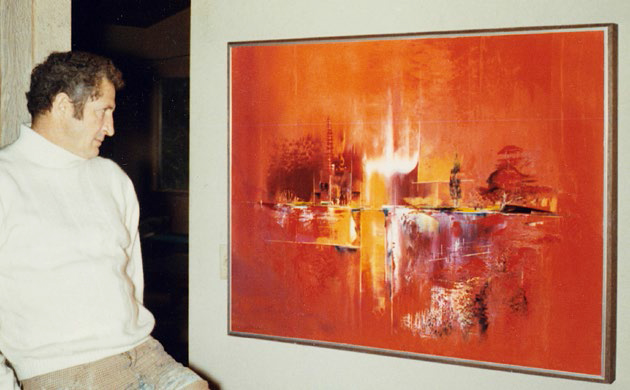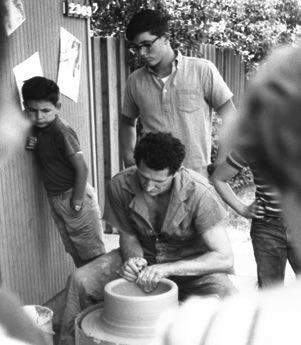Something in the Air - Page 5
From Driveway to Artistic Acclaim
 |
|
|
 |
|
|
Next-door neighbor Les Lambson was one of the first artists drawn out into the streets of Fairglen in the early 1960s.
When he rolled his potter's wheel onto his sloped driveway, all the Eichler neighborhood kids would gather around him like a pond full of koi at feeding time. We watched wide-eyed, like children in a Keane painting, as Lambson spun a wet, messy blob of clay into a work of functional art.
Little did we know that we were also witnessing the budding of an artist and his extraordinary career.
Lambson was not just a potter; he was also a painter, politician, philosopher, and college professor.
On summer afternoons, his garage door would slide open. Then we'd see him inside, shuffling around, mumbling in colorful language about his latest artwork, and utilizing the oddest assortment of tools—twigs, branches, tree bark, scraps of wood, and stones.
Soon Lambson would scratch through strata of paint layered on Masonite creating wonderful Asian-inspired paintings. We'd lean against the wall of his dusty garage and watch transfixed as he cut and sanded the wood he fashioned into frames. Once in a while he'd ask me to fetch a strange stick or brush, and I'd become his dutiful eight-year-old apprentice.
In those early days, Lambson gave away many of his paintings to neighbors, including to my parents, for no apparent reason other than to see the pleased expressions on their faces. Several of our neighbors had the same familiar-styled paintings on their walls, all courtesy of the artist. At the time, while fame had not yet found Lambson, the generous heart of an artist was already on display.
Though Lambson had been getting exposure mostly at the local level, his work soon received international recognition. Inspired by the revered Japanese artist Shōji Hamada, Lambson's paintings fused both Asian and European technique into a style that was earthy and fresh.
As Lambson's reputation spread, the likes of Frank Sinatra, Winston Churchill, Andy Williams, and other celebrities reportedly purchased his paintings, and for prices stretching into the thousands of dollars. You couldn't walk into an art gallery from the late 1960s to the early 1980s without running into one or more Lambson paintings or lithographs.
By the late-'60s, Lambson and his family moved away from San Jose, and into a modern glass-walled house in Arizona that was not unlike their Fairglen Eichler. My parents would occasionally take road trips to visit the Lambsons, and, more often than not, they'd return home with an original painting or two wrapped up and tied to the roof of the family Buick.
In 1981, while walking through the renowned Hotel del Coronado in San Diego, I spotted a series of Lambson paintings hanging in the hallways.
In that moment, with my mind reeling, I was back home again—with Art in Our Alley and the Fairglen Art Fair in full swing. There I was, in Les Lambson's driveway, as he scraped out another enchanting work of art, sawdust in his hair and paint smeared across his cheek.
"Hey Carol," I could hear Les say, "get me that piece of wood over there for this new frame, will you? Oh, and give me a smile."
• Author Carol Sveilich reveals her adventures on everything mid-century and coming of age in a San Jose Eichler. Her ‘Reflections From a Glass House: A Memoir of Mid-Century Modern Mayhem’ is available in soft cover, e-book, as well as audiobook
Additional photography: Joe Sveilich, Ernie Braun, Fairglen's cast of unknown shutterbugs from yesteryear; and courtesy the archives of Carol Sveilich, Steven Thatcher, Bill Pfahnl, Michael Greene, Fred Caploe, Stella Slyngstad




